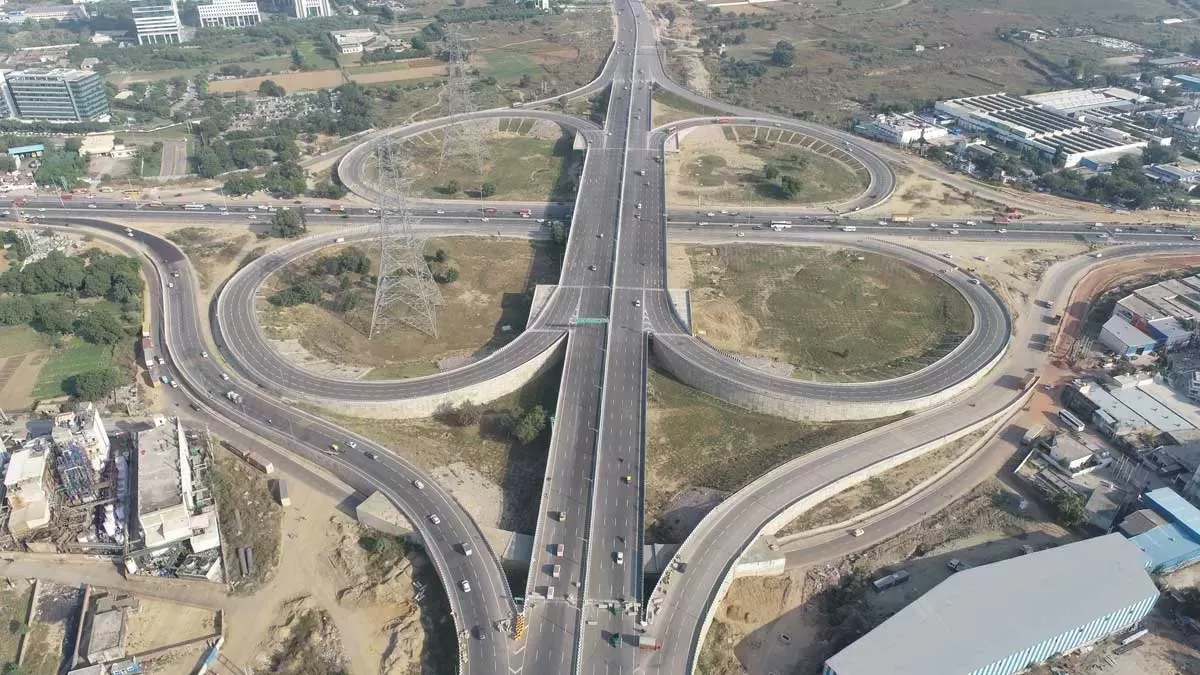The construction of highways has crossed several milestones of late. In FY24, the National Highway Authority of India (NHAI) broke the previous record of the length of NH projects constructed in one year, adding 6,644 km, 20 per cent more than the 5,544 km constructed in FY23, and around 53 per cent more than the 4,331 km constructed in FY22.And capital expenditure by the highway authority touched Rs.2,070 billion in FY24, also an all-time high, 20 per cent higher than the Rs.1,730 billion spending in FY23 and Rs.1,720 billion in FY22.“For FY25, NHAI has set a target of around 5,000 km but we’re confident of surpassing this to set another record,” says Santosh Kumar Yadav, IAS, Chairman, NHAI, exclusively to CW. “We have regularly been monitoring projects at various levels and are in touch with state governments and stakeholders to resolve any issues pertaining to the development of national highways in regions across the country.”Smoothening developmentNHAI has launched the ‘NHAI One’ mobile app to facilitate most of the crucial onsite requirements in the execution of NH projects. The use of drones has been mandated for the monthly video recording of NH projects during all stages of development – construction, operation and maintenance.A new Detailed Project Report (DPR) Cell at NHAI headquarters in New Delhi aims to ensure the highest construction standards, cost-effectiveness and timely completion of projects. The DPR is an essential component for the successful implementation of projects and helps to address execution challenges. It includes surveys, investigations and designs related to project execution.“The DPR cell will provide expert inputs and enable end-to-end monitoring of the DPR for NH projects,” says Yadav. “The cell will ensure quality DPRs are prepared and reviewed before the implementation of the projects, and help finalise parameters of highway components (highway and structures) as per Indian Roads Congress [IRC] specifications and standards.”Challenges associated with DPRs make this move very welcome. “Sometimes, DPRs underestimate the land needed for the project, leading to delays in acquisition and additional costs,” says Arpan Ghosh, President – Engineering, Cube Highways Technologies. “The quality and expertise of consultants preparing the DPR can vary significantly. In some cases, consultants may lack the necessary experience or local knowledge, leading to flawed DPRs. There is often insufficient accountability for consultants who produce substandard DPRs, leading to recurring issues across different projects. Inaccuracies in technical design, such as the alignment of the highway and placement of bridges or drainage systems, can lead to costly modifications during construction.”According to Ghosh, the fact that NHAI has proposed an increase in the threshold for preparing DPRs, thereby moving from a least cost to a fixed-cost model, will help improve the quality of DPRs to bring them on a par with international standards and avoid project delays.Pavement qualityEarlier this year, Union Minister for Road Transport & Highways Nitin Gadkari committed to equipping India with world-class, modern infrastructure at an accelerated pace. ‘World class’ is a definitive deliverable, measurable through indices such as the bump integrator value (a ratio of the cumulative vertical displacement to the distance travelled, expressed in mm/km) and the International Roughness Index (IRI).Road roughness refers to irregularities in the pavement surface that adversely impact riding, and additionally increase the fuel consumed and maintenance cost. Shrinath Rao, Senior Vice President & Head, Transportation Infrastructure, L&T Construction, compares India’s accepted indices with a few other countries:According to Rao, “Adopting high-performance bitumen in the wearing coat has significantly improved the riding quality as well as durability of roads. Further, using full-width pavers (up to 13 m) to avoid joints has improved riding quality; using computerised level control paving such as ‘Paveset’ has delivered perfect levels and superior riding quality; and using an improvised bituminous mix design has improved quality control in production and laying.”Stone matrix asphalt (SMA), polymer-modified bitumen (PMB), and highly modified bitumen (HiMA) have been adopted in road construction to enhance the durability, performance and lifespan of pavements, according to Ghosh. “SMA and PMB provide excellent resistance to rutting and deformation, which is particularly important in high-temperature regions or under heavy traffic conditions. PMB and HiMA improve the elasticity and flexibility of the asphalt, allowing the pavement to better withstand temperature variations and heavy loads without cracking or deteriorating.”NHAI has been emphasising the adoption of new technology, materials and latest advancements in AI technology for the development of highways. The innovative use of alternative/waste material like reclaimed asphalt pavement (RAP), plastic waste, steel slag, phosphor-gypsum, fly-ash is being encouraged for the economical construction of more durable national highways.“The use of locally available material is also being promoted through IRC guidelines and codes,” says Sanjay K Nirmal, Secretary General, Indian Roads Congress. “Recently, IRC has taken up the preparation of guidelines for the use of steel slag, which is a waste product generated by steel factories, in the construction of roads in the vicinity of steel manufacturing states like Odisha and Jharkhand. Central Roads Research Institute [CRRI] has successfully completed some pilot projects using this material.”User-friendly initiativesNHAI has also introduced technologies to facilitate the use of the country’s expanded road network. ‘Rajmarg Yatra’, a citizen-centric mobile application with inbuilt complaint redressal system, has been introduced to ease commuting on NHs. This initiative has enhanced road safety and digital enforcement on NHs and expressways. For the seamless movement of vehicles at toll plazas, a ‘toll plaza waiting time alert software’ has been developed. This portal provides live updates of traffic conditions at all NHAI toll plazas.NHAI is implementing an advanced traffic management system (ATMS) on various access-controlled corridors and expressways. The technology includes the deployment of a video incident detection and enforcement system (VIDES) to emphasise the digital enforcement of traffic rules and enhance incident management on NHs.On the anvilIn upcoming highways, NHAI will be specifying the automated road survey system (ARSS), also known as network survey vehicle (NSV). This specialised infrastructure management tool comprises vehicles equipped with advanced sensors and data acquisition systems to systematically collect data on road inventory and condition at highway speeds up to 100 kmph. The data will facilitate decisions on pavement maintenance, asset management and infrastructure planning, ultimately contributing to the safety and efficiency of transportation networks.NSV technology is more accurate than conventional systems, generates reports quickly, and is cost-effective. To effectively leverage this technology, NHAI has customised the framework as per Indian requirements and defined timelines for the processing of data and submission of reports. NHAI is also using well-established GIS technology for the quick analysis of results, to enhance informed and timely decision-making.To provide NH users a seamless and barrier-free tolling experience, and enhance efficiency and transparency of toll operations, the Government of India plans to introduce the global navigation satellite system (GNSS)-based electronic toll collection (ETC) system. NHAI will implement the GNSS-based ETC system within the existing FASTag ecosystem, initially using a hybrid model where both RFID-based ETC and GNSS-based ETC will operate simultaneously. Dedicated GNSS lanes will be available at toll plazas, allowing vehicles using the GNSS-based ETC to pass through freely. Eventually, all the lanes will be converted to GNSS lanes.Next stepsTo further improve riding quality, Rao proposes proof-rolling the base layers, which would also remove undulation in the final bituminous layers. Further, a ‘super pave’ mix design in the bituminous mix would produce a performance-based design and improve riding quality, as would using performance-grade bitumen. He also recommends using a laser-based profilometer to identify rough patches for repairs.“Warm-mix asphalt (WMA) and thin overlays should be adopted to enhance road construction efficiency, sustainability and cost-effectiveness,” says Ghosh, explaining that as WMA is produced at lower temperatures than traditional hot-mix asphalt, it significantly reduces the energy consumed and greenhouse gas emitted during the manufacturing process. This makes it a more environmentally-friendly option. WMA also improves the workability of the asphalt, making it easier to handle and compact. This, in turn, can lead to better pavement quality and longer-lasting roads.WMA allows for extended construction seasons in cooler climates because it can be laid at lower temperatures, a flexibility that can help meet project deadlines and reduce delays.Using thinner (not exceeding 20 mm) bituminous overlays for the surface course of low-traffic roads, which don’t need the minimum 30-mm thickness specified in codes, helps to preserve resources and save costs, according to Manish Chitkara, Managing Director (Highways Portfolio), Sekura India Management.“Thin overlays can improve surface texture, reduce noise and enhance skid resistance, leading to safer and more durable roads,” adds Ghosh. “They are particularly useful for preventive maintenance, helping to delay the need for more extensive and expensive repairs.”Climate-resilient materialsClimate change is causing extreme weather events, rising water levels (unpredictable high flood levels) and shifting precipitation patterns, all of which impact the performance of new roads as well as influence the construction window, believes Atasi Das, Assistant Vice President, GR Infraprojects. “Weather shifts also make the adoption of new technologies risky. No contractor wants to incur a loss because of incorrectly chosen materials.”The truth is, adapting highways to be resilient against climate change is no longer an option but a necessity to protect the investment and the community, and ensure the asset continues to serve, in the view of Satyanarayan Purohit, Vice President, Dilip Buildcon.These adaptive measures span a highway project from the foundation to the protection of the finished pavement, and include technologies used for soil stabilisation, embankments, hill slope and surface protection, he continues. “Innovative materials that are more durable and can withstand extreme weather conditions are critical, and could mandate changes to the project specifications. For example, high-performance bitumen, concrete, steels and geotextiles. Polymer-modified bitumen, crumb rubber-modified bitumen (CRMB), road mesh grids, glass fibres, etc, are all useful.”Among game-changing materials in the effort to build climate-resilient roads, Das counts porous or permeable pavements that allow surface water to infiltrate into the ground, thus reducing runoff and preventing flooding. “Also, recycled materials that reduce the environmental impact of road construction and maintenance; fibre-reinforced concrete that improves the strength and durability of concrete pavements, making them more resistant to cracking and weathering; location-specific, temperature-resistant bitumen/asphalt (for flexible pavements) that fights differential temperature; glass fibre-reinforced polymer in lieu of steel that reduces the carbon footprint, etc.” To construct world-class, climate-resilient roads, we need to promote new and innovative materials and technology; that is, commercial chemical stabilisers, geo-textiles, ultra-high/high-performance concrete and FRP bars, says Nirmal.Protection against extremesClimate modelling and simulation, including predictive analytics and risk assessment, would help predict future climate conditions, identify vulnerable areas and develop risk maps through zonation, paving the way for proactive measures for roads and other infrastructure, according to Das.Within cities, she says green infrastructure, such as urban forests and green roofs that absorb rainwater, and water diversionary assets, such as rainwater harvesting, stormwater management ponds and bioswales, could help protect roads from excess runoffs. Also, road infrastructure should be smartened by deploying instrumentation and sensors that monitor the pavement, flow of traffic and weather patterns, allowing for real-time adjustments and maintenance. In particular, adaptive systems can adjust to changing conditions, such as temperature fluctuations and heavy rainfall.Hill roads need special treatment to be made both climate and disaster-resilient, adds Das. Insofar as guidelines are concerned, she says, “Several key specifications will need to be adjusted to ensure their longevity and functionality in the face of changing environmental conditions.”Das cites the need for precise specs on the selection of materials for durability and resilience against heavy rainfall, flooding, differential temperature, freezing and thawing. “The specs on recycled content should be crystal clear and low-carbon materials should be encouraged,” she adds. “The Government should transfer the benefit of this shift to the implementing agency in the form of carbon credits. Codes, tools and software to measure the carbon footprint and thereby credit the party are still being developed; this must be accelerated. Specifications must also be developed for climate-resilient foundations to withstand potential ground movement, subsidence and erosion caused by climate change. Geotechnical and geological maps for guidance are vital for the quick assessment of soil conditions and to identify potential vulnerabilities.”Das also suggests that all the codes and specs from multiple authorities – IRC, Bureau of Indian Standards, MoRTH Specifications, circulars issued by the Ministry, NHAI, NRRDA, PMGSY – be collated and corroborated for better application and adaptation of climate-resilient roads. Too many codes and specs sometimes become too confusing and contradictory.Coming to design, Purohit points out that the design of a highway must consider future probable climate scenarios. For instance, in flood-prone areas, certain structures may need to be elevated and drainage systems be of a greater capacity to withstand potential climate change events. The consequential initial increase in cost would be around 7 to 8 per cent; however, in the long run, such changes would save on maintenance costs and increase climate resiliency.Roads with modular components would allow for easier adaptation to changing conditions, adds Das. “Rather than building many greenfield corridors, we should equally focus on developing specs for retrofitting existing roads to make them more climate-resilient.”In the face of the repercussions of a warming planet, Purohit would like the construction industry to lead with innovation and forward-thinking strategies.Repairs & maintenanceEvery highway needs repairs and maintenance at some point to preserve and enhance its residual life; the big question is when, says Chitkara. “This intervention period may vary anywhere from six-seven to eight-10 years depending on multiple factors such as the traffic volume, traffic loading, climate, initial pavement design period, quality of construction during the initial design period, etc. Clearly, the longer the intervention period, the better.”He points out that the choice of materials and effective technology (products, processes, systems) for the repair and maintenance of bituminous pavements significantly impact pavement life. “For instance, most highways constructed with conventional bitumen cannot cope with high traffic intensity, overloading and variations in the daily and seasonal temperature of the pavement. These conditions hasten the development of distress like rutting, cracking, bleeding, shoving and potholing of bituminous surfacing. However, repairing the pavement with modified bitumen-like, factory-produced, polymer modified bitumen significantly improves its performance and extends the interval until the next renewal. Modified bitumen in bituminous overlays outperforms conventional bitumen under extreme traffic and climatic conditions.”Chitkara lays stress on the use of site-specific, performance-grade bitumen based on the performance requirements of the project, instead of regular viscosity-grade bitumen; innovative and advanced materials like glass grid (which prevents cracks in the lower layers to come on top and increases structural strength); multiplex sensors in pavers for better riding quality; intelligent compaction systems to achieve the desired density of bituminous mixes, thereby reducing the occurrence of spot failures in pavements; and an excellent quality assurance/control programme. “All this is easier said than done and requires meticulous, diligent efforts,” he cautions. Further, using greater quantities of RAP material in the resurfacing and reconstruction of pavements would reduce the requirement of fresh bitumen and virgin aggregates required to produce the bituminous mix, continues Chitkara. “Such mixes deliver economic and environmental benefits and sometimes perform better (they have higher rut resistance) than conventional bituminous mixes.”RAP material can also be used in pavement preventive measurements like micro surfacing, chip seal and slurry seal, he adds. “India could gain from increasing the percentage of RAP to 60-80 per cent in pavements as various mining bans and depleting natural resources are making it increasingly difficult to get good quality aggregate.” Smart drainage sensors can help monitor drains in real time, especially in urban areas, to help prevent the failure of asphalt (black) pavement, a technique Chitkara observes is under development in countries like Australia.Despite the clear advantages of these materials and technologies, he says resistance from various stakeholders including contractors, independent engineers and the highway authorities presents a big challenge. For example, the use of RAP in bituminous concrete and a high RAP content in dense bituminous macadam (the layer below the top surface course) initially saw a lot of resistance, although for various logical reasons in their understanding. To help overcome resistance, he proposes continuous technical deliberations with independent engineers, use case demonstrations from credible projects, specific research and testing services from prominent research institutes like the prestigious IITs, NITs and CRRI.Research roadmapResearch is a priority of the authorities. Consequently, “sufficient budget has been allocated for research into the use of indigenous materials for road construction by MoRTH; we don’t want to restrict ourselves to imported western codes for the preparation of IRC codes,” says Nirmal.India has a collaborative approach to research in road/highway construction technologies, which bodes well for the industry, says Manish R Sharma, Partner and Leader - Infrastructure, Transport & Logistics, PwC India.To improve the performance of bitumen, a new R&D study has been commissioned through IIT Delhi and CRRI to identify and recommend the kind of bitumen best suited for the construction of roads in different temperature zones in the country, shares Nirmal. “The IRC code will be suitably modified based on this outcome.”While Sharma notes that themes such as GPS-based tolling, sustainability in construction (precast policy, recycled aggregates, warm mix asphalt technology, etc) and the electric highways concept pilot on the Delhi-Jaipur Highway have been taken up, the focus also needs to extend to tech-enabled solutions in both infrastructure development (construction quality) and service quality improvement. Enabling partnerships with global road agencies to exchange ideas and research findings would also be desirable. Das points to the need for the wider distribution of research outcomes. “In the US, any university or institutional research or research by the Federal Highway Administration or Department of Transportation is freely available but, in India, research is considered a top secret,” she says. “Research by CRRI is a good example. Then how will the industry gain?”




















